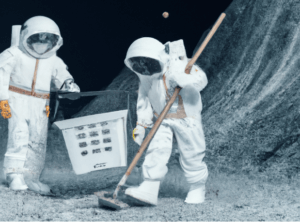
Land Conservation on the Moon
By Steve Stawarz (Advisory Council Member, The Conservation Foundation)
Given recent initiatives by private organizations to place landers on the moon, including one for the first lunar data center that landed in March 2025, discussing land conservation on the moon may be relevant. Land conservation on the moon is not a widely discussed topic, primarily due to the moon’s unique characteristics and lack of a traditional ecosystem.
Regardless, several key considerations arise when planning activities there. These include environmental preservation, sustainability, and governance to prevent excessive exploitation. Some critical factors include:
- Minimizing Lunar Surface Disturbance
- Reducing the footprint of infrastructure (e.g., landing pads, habitats, mining operations) to prevent widespread disruption of the lunar surface material.
- Managing lunar dust, which is highly abrasive and electrostatically charged, prevents it from contaminating equipment and habitats.
- Waste Management and Pollution Control
- Preventing long-term debris accumulation from human missions, spacecraft, and mining activities. Nobody wants the moon to become a junkyard.
- Developing protocols for recycling and waste reduction to maintain a clean lunar environment.
- Resource Utilization and Sustainability
- Implementing responsible extraction methods for lunar ice, lunar surface material, and minerals to avoid long-term depletion.
- Establishing guidelines for in-situ resource utilization (ISRU) to ensure equitable access and minimal environmental impact.
- Biodiversity and Ecological Ethics
- While the Moon lacks life, ethical considerations arise regarding introducing Earth-based biological materials that could alter the lunar environment.
- Future terraforming discussions (if any) must weigh the consequences of altering a pristine celestial body.
- Legal and Governance Frameworks
- The Outer Space Treaty (1967) prohibits national appropriation of lunar land but lacks detailed conservation rules. The Outer Space Treaty lays the groundwork for ethical exploration, but future agreements will be necessary to establish comprehensive land conservation policies for the Moon and beyond.
- New agreements, such as the Artemis Accords, emphasize responsible exploration, but more specific conservation policies may be needed. While the Artemis Accords introduce land conservation principles through the preservation of historical sites, responsible resource use, and debris management, they do not create a fully developed conservation framework for the Moon. Future agreements or amendments may be needed to ensure sustainable and environmentally conscious lunar development.
- Preservation of Scientific and Historical Sites
- Protecting Apollo landing sites, rover tracks, and other historical artifacts as part of humanity’s cultural heritage. The World Monuments Fund recently selected the moon as a historical preservation site.
- Avoiding contamination of scientifically valuable regions, such as permanently shadowed craters that may contain ancient water ice.
In summary, while the moon doesn’t have traditional land conservation needs like Earth, there should be discussions about protecting lunar environments from human activities and ensuring the responsible and sustainable use of lunar resources.
It’s an evolving field, and international cooperation and legal frameworks will be crucial in addressing these concerns. As one CEO of a prominent conservation organization told me, “Humans should always take care of the land wherever they may go.”